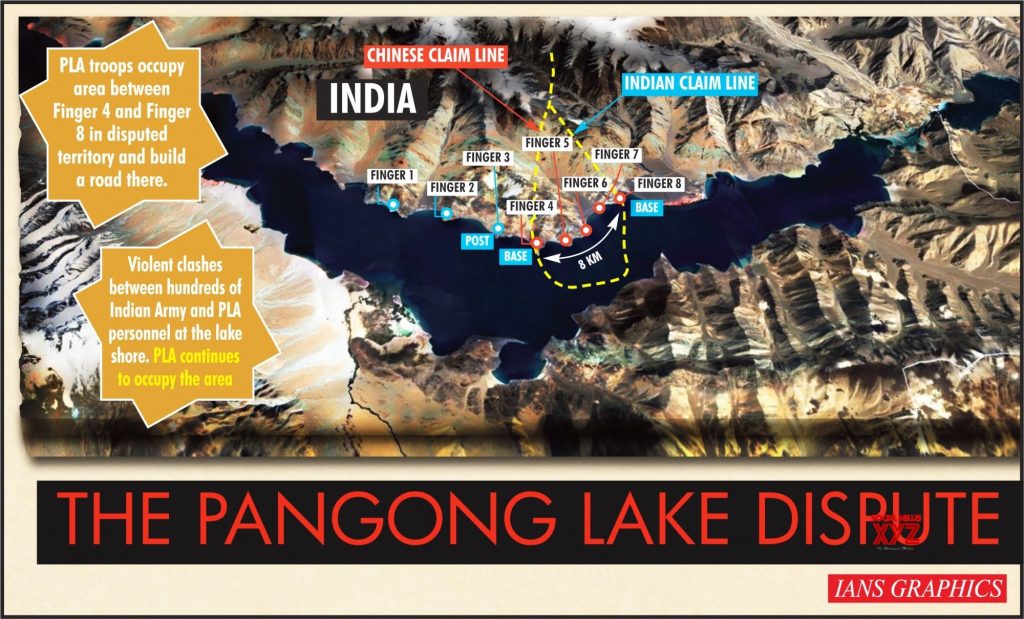
Manas Dasgupta
NEW DELHI, Sept 1: Despite China’s repeated reiterations that it was against increasing tension on the borders with India and want a negotiated settlement, the ground reality looked to be different. The Saturday’s intrusion into the Indian territory by China’s Peoples’ Liberation Army in eastern Ladakh was again a testimony of the double standard adopted by it.
Even as the Chinese foreign minister again claimed on Tuesday that the border clashes were caused by the “absence” of clear demarcations on the Indo-China border and that China was all for a “negotiated settlement” of the dispute, Beijing upped the ante saying that India had “illegally crossed” the Line of Actual Control and the Chinese president Xi Jinping telling the country’s highest-level meeting on Tibet that safeguarding border security should be a priority, clearly hinting that India and not his country was at fault for the border tension.
Alarmed at the latest provocation by Chinese troops, India has reinforced its border forces with additional deployment and an army spokesman claimed that the Indian army had succeeded in pushing back by about four kilometres the PLA forces that violated the borders on Saturday night. This was even as reports from Monday’s flag meeting at Chushul between the two brigade commanders suggested a ‘stormy’ interaction which was unlikely to help the matters. Repots received here said while the Chinese side insisted that Indian troops move out of the heights they had “occupied” on the southern bank of Pangong Tso, the Indians refused, arguing that the Chinese would occupy those areas in case they were vacated now. The meeting in Chushul was continuing even on Tuesday while India’s top security advisor Ajit Doval held several rounds of meetings with the defence personnel during the last two days reviewing the situation on the Indo-China border.
In case the dispute was not quickly resolved through bilateral talks at the political, diplomatic or at the most army officers’ levels, the chances of a military escalation on the borders could not be ruled out considering the unusual sharp irreconcilable statements issued by the two armies on Monday.
These statements followed the moves by the two armies on the southern bank of Pangong Tso. Unlike the northern bank of Pangong Tso where the Indian Army only carry out patrolling, the southern bank was strongly held by the Indian troops very close to the LAC. China’s PLA apparently was fully aware of the Indian deployment and had not attempted any transgressions, even though it repeatedly claimed that the LAC was eight kilometres west of the Indian posts.
In the face of India’s assertion that it took measures to thwart China, the attempted ingress by the PLA to occupy dominating heights in this area, was a clear indication that the PLA was trying to change the status quo in all areas up to its perception of the LAC. If this trend continued, the PLA might attempt similar moves in places like Demchok, Chumar and some other points. With the situation already on a tinderbox, any misapprehension or misunderstanding could lead to a quick escalation between the two sides.
As the latest round of tension involved a new area on the LAC, away from the friction points of the last four months, China was dropping hints that the entire disputed border in Ladakh was “open for any military moves.” The expansion of the frontage of tensions with both sides constantly trying to gain an upper hand in areas manned heavily by troops of both sides, gives clear indication that the situation in the Ladakh border was “unstable” and could ignite a massive military escalation. The statements issued by the two armies did not agree even on the date of the incident leave alone the nature of the incident on the LAC. This pointed to a complete breakdown of trust between the two sides, where every single move would be viewed with suspicion and could easily lead to an over-reaction.
In its statement, the Indian Army said PLA had “carried out provocative military movements to change the status quo.” It stated that while India was “committed to maintaining peace and tranquility through dialogue, (it) is also equally determined to protect its territorial integrity”. This was in line with CDS General Bipin Rawat’s view stated last week that “military options to deal with transgressions by the Chinese Army in Ladakh are on but it will be exercised only if talks at the military and the diplomatic level fail”. In contrast, the PLA on the other hand after alleging that “this move by the Indian side seriously violated China’s territorial sovereignty and severely undermined the peace and stability of the Sino-Indian border area,” claimed that it was “taking necessary counter-measures, (and) will pay close attention to developments and resolutely safeguard China’s territorial sovereignty and peace and stability in border areas”.
People in India are already angry with China over its moves in Ladakh, and Monday’s exchange was bound to further inflame public opinion against China. According to the reports emanating from Beijing, the mood in China was no better. A recent survey conducted by the ‘Global Times’ and China Institutes of Contemporary International Relations (CICIR) that about 70 per cent of the respondents advocated that the Chinese government should be tough in “fighting back India’s provocations.” The survey reported 89.1 per cent respondents supported military retaliation, with 50.4 per cent of them “strongly supporting” self-defence and counterattacks.














